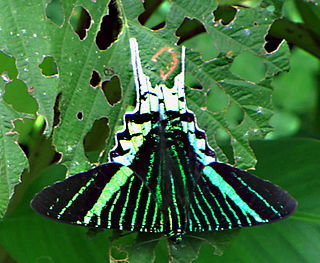
Atteva is a genus of moths in the monotypic family Attevidae. The group has a pantropical distribution; however, the range of at least one species, Atteva aurea, extends into the temperate zone. No consistent hypotheses regarding the relationships, placement, and ranking of Attevidae have been published, but the prevalent view is that they likely form a monophyletic group within the Yponomeutoidea.

Gasteracantha is a genus of orb-weaver spiders first named by Carl Jakob Sundevall in 1833. Species of the genus are known as spiny-backed orb-weavers, spiny orb-weavers, or spiny spiders. The females of most species are brightly colored with six prominent spines on their broad, hardened, shell-like abdomens. The name Gasteracantha is derived from the Greek gaster (γαστήρ), meaning "belly, abdomen", and akantha (άκανθα), meaning "thorn, spine". Spiny-backed orb-weavers are sometimes colloquially called "crab spiders" because of their shape, but they are not closely related to the true crab spiders. Other colloquial names for certain species include thorn spider, star spider, kite spider, or jewel spider.

The Uraniinae or uraniine moths are a subfamily of moths in the family Uraniidae. It contains seven genera that occur in the tropics of the world.

The black sunbird is a species of bird in the family Nectariniidae. It is found in eastern Indonesia and New Guinea. Its natural habitats are subtropical or tropical moist lowland forest and subtropical or tropical mangrove forest.
Batracharta is a genus of moths of the family Erebidae. The genus was erected by Francis Walker in 1862.

Dictyestra is a monotypic moth genus of the family Noctuidae erected by Shigero Sugi in 1982. It contains only one species, Dictyestra dissectus, the angle network armyworm, first described by Francis Walker in 1865. It is found from India to Indochina, Sri Lanka, China, Japan, Sundaland and the Philippines and from Sulawesi to the Moluccas and New Guinea.
Hipoepa is a genus of moths of the family Noctuidae first described by Francis Walker in 1859. It is sometimes considered to be a synonym of Polypogon.

Targalla is a genus of moths of the family Euteliidae. The genus was erected by Francis Walker in 1858.

Macroglossum corythus is a species of hawk moth of the family Sphingidae. It was described by Francis Walker in 1856 and is found throughout the Indo-Australian tropics east to New Caledonia.

Comostola is a genus of moths in the family Geometridae erected by Edward Meyrick in 1888. They are found primarily in Asia and Australia.

Ornithospila is a genus of moths in the family Geometridae described by Warren in 1894.

Ozola is a genus of moths in the family Geometridae first described by Francis Walker in 1861.

Sasunaga leucorina is a moth of the family Noctuidae. It is found in Sundaland, Sulawesi, the southern Moluccas, New Guinea and Queensland.

Comostola cedilla are a species of moth of the family Geometridae. It is found in New Guinea, Queensland, the southern Moluccas, Sulawesi, the Philippines, Borneo, Sumatra and Peninsular Malaysia.

Nyctemera baulus is a moth of the family Erebidae. It is found from India to Samoa. Records include Queensland, Indonesia and New Guinea.
Garella is a genus of moths of the family Nolidae. The genus was erected by Francis Walker in 1863.

Ambulyx semifervens is a species of moth of the family Sphingidae. It originates from Indonesia.

Didiguides is a monotypic moth genus of the family Nolidae erected by Lutz W. R. Kobes in 1994. Its only species, Didiguides semifervens, was first described by Francis Walker in 1863. It is found on Borneo, Sumatra and Sulawesi, as well as in New Guinea and on the Bismarck Islands. The habitat consists of dipterocarp forests, including alluvial forests.
Utetheisa specularis is a moth in the family Erebidae. It was described by Francis Walker in 1856. It is found in Indonesia.
Chorodna strixaria is a moth of the family Geometridae first described by Achille Guenée in 1858. It is found in India, Vietnam, Sulawesi, the Philippines, the Moluccas, New Guinea, Australia and Sri Lanka.















